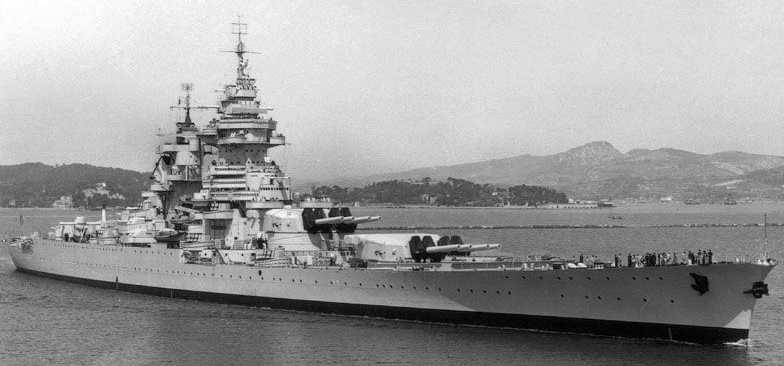The last battleship guns developed by France, these weapons had an unfortunate war history.
Richelieu had fired only six shots from each of her guns during abbreviated gunnery trials on 13-14 June 1940 before she had to flee to Africa to escape the invading Germans. At the time of her escape, she carried 296 APC rounds, but only 198 quarter charges and her ammunition handling equipment was barely functional.
During the first day of the British attack on the French Fleet at Dakar in September 1940, Richelieu returned fire from Turret II - the crew of Turret I having been placed ashore to man coast defense batteries - but the two starboard guns of this turret both failed at the first salvo. The inner gun No. 7 was shattered and the outer gun No. 8 bulged with the rifling gashed for 8 meters (26 feet). Guns No. 5 and No. 6 remained in action for the rest of the first day, but the next day the gunnery crewmen were switched to Turret I. Rounds fired from this turret used propellant charges that produced less pressure than the ones used on the previous day and thus did not suffer bore prematures. However, these lower pressures also gave significantly less range than estimated which caused fire control problems. Richelieu fired a total of 24 rounds during both days of the battle but she failed to score any hits. A few days after the battle, the French attempted to clear No. 5 and No. 6 guns by fire, but No. 5 gun failed in the same manner as had No. 8 and the gun stuck in the recoil position at an angle of 15 degrees. After this, No. 6 gun was cleared by hosing down the charges and then removing them and the projectile through the breech.
The cause of these problems was eventually traced to a defective shell design. The original APC projectiles had 4 cavities in the base which were designed to accept cartridges containing toxic war gases. These cavities were protected by a base cap, but this broke under the pressure generated when the guns fired. Splinters from the broken base cap smashed through the gas cavities and into the burster charge which then detonated. After this incident, a new base cap was produced and the gas cavities were filled in with cement.
Sister-ship Jean Bart had only her Turret I guns installed when France fell in May 1940. Of the four guns intended for her Turret II, two were at dockside at St. Nazaire as France collapsed. One of these was loaded onto the cargo ship Mécanicien Principal Lestin but the transfer crane failed when trying to load the second gun. The cargo ship sailed for North Africa, but she was attacked and sunk by German aircraft off the Gironde shortly after leaving harbor. The second gun was reportedly mutilated on the dock before being captured by the Germans. The third gun was captured in transit to St. Nazaire as was the fourth gun which was still at the gun factory at Ruelle.
A total of seven guns were captured by the Germans and three of these were taken to Norway. It was planned to install them in a coastal battery at Vardaasen, but this battery never became operational. After the war, at least five of the captured guns were returned to France where they were then refurbished at Ruelle.
During Richelieu's refit in the USA in 1943, her three ruined guns were replaced by guns removed from Jean Bart's Turret I. It is apparently untrue that Richelieu's guns were bored out to 15.0" (38.1 cm) during this time, as French records indicate that they remained at 380 mm (14.96"). Sometime after this refit, new APC projectiles designed to meet French specifications were specially built for her by the Crucible Steel Company of America.
Postwar, additional guns were built and these were primarily used to arm Jean Bart.
Richelieu had delay coils for the center guns of each turret fitted in 1947-1948 when a tighter dispersion pattern was desired in order to take the maximum advantage of radar fire control. During tests at Mers el-Kébir in May 1948, the measured average dispersion at 26,500 meters (29,000 yards) was 525 meters (575 yards) without the firing delay and 300 meters (330 yards) with a 0.060 second firing delay (at this time the guns had all fired more than 200 shells without refit).
These weapons were mounted in quad turrets, which were really more of a dual-twin arrangement. The quad mounting was chosen as a result of weight considerations, as it meant less turret and protective belt armor was required, an important consideration for ships designed under Treaty limitations. However, this configuration did mean that a single hit could destroy half of the main armament. The individual guns were sleeved, but the relative motion of the guns in each pair was limited. The French were apparently unhappy with the all-forward arrangement, as the design for the last ship in the class, Gascogne, returned to the more traditional fore-aft arrangement.
These guns were of complex assembly and a curious mix of modern and traditional French methods. Model 1935 had 31 components consisting of an A tube, breech bush, twenty hoops, breech ring, four tubes to the muzzle ending in the muzzle bush and a locking ring. Used a stepped loose liner that was held in place by a ring screwed into the breech end of A tube. Model 1936 was simpler, having only 20 components with the number of hoops reduced to ten and the number of tubes reduced to three. Both models were autofretted.
The Welin breech mechanism opened upwards automatically as the gun ran out after firing. It was hydro-pneumatically powered and balanced by counterweights. An automatic lock with ten electric tubes for firing was fitted to the breech mechanism.
A total of 21 guns were built between 1936 and 1940 with an additional 9 guns built post-war. All of the post war guns were scrapped, but the pre-war guns have fared better. One gun from Richelieu is on display at the military harbor of Brest, near Recouvrance Bridge. A second gun is on display at Gâvres, a third at Ecole Navale Lanvéoc Poulmic and a fourth is at Ruelle. A fifth gun was removed from Richelieu as she was being scrapped and then used by the Italian Navy during the 1960s to test high-velocity projectiles. This gun is now on display at the Naval Arsenal in La Spezia.
| Designation | 380 mm/45 (14.96") Model 1935
380 mm/45 (14.96") Model 1936 |
|---|---|
| Ship Class Used On | Richelieu, Gascogne and Alsace classes |
| Date Of Design | 1935 |
| Date In Service | 1941 |
| Gun Weight | 207,200 lbs. (94,130 kg) |
| Gun Length oa | 704.0 in (17.882 m) |
| Bore Length | 679.4 in (17.257 m) |
| Rifling Length | 557.4 in (14.157 m) |
| Number Of Grooves | (80) 0.146 in deep x 0.350 in (3.7 mm x 8.9 mm) |
| Lands | 0.236 in (6.0 mm) |
| Twist | Uniform RH 1 in 25.57 |
| Chamber Volume | 27,863 in3 (456.6 dm3) |
| Rate Of Fire | 1.3 - 2.0 rounds per minute 1 2 |
- ^The rate of fire was hampered by the slow rate in which the hoists could deliver projectiles. Reportedly, gunnery trials in the spring of 1940 for Richelieu achieved no more than 1.33 rounds per minute. However, "French Battleships: 1922 - 1956" states on page 126 that in July 1940 that "it took fifteen minutes to bring up a charge from the magazines to the guns, so the ship was realistically capable of firing only two initial four-gun salvos before her big guns fell silent." Some of the problems must have been rectified, as she was able to fire a salvo every two minutes during the British attacks on Dakar in September 1940. Postwar, her reloading gear was modified and improved and she could then fire every 32 seconds. Jean Bart as completed could achieve the same rate of fire.
- ^A spanning tray to protect the breech threads ran in and out automatically. Complete ramming time was 13.5 seconds. The breeches were operated hydro-pneumatically and opened upwards automatically during the runout cycle. Breech opening and closing times are both given as 3.5 seconds.
| Type | Bag |
|---|---|
| Projectile Types and Weights 1a 2a 3a | APC Model 1936: 1,949 lbs. (884 kg) 4a 5a APC Model 1943: 1,951 lbs. (885 kg) (USA) HE Model 1945: 1,949 lbs. (884 kg) (Britain) HE Model 1949: 1,938 lbs. (879 kg) |
| Bursting Charge | French APC: 48.3 lbs. (21.9 kg) Mn.F.Dn
Crucible Steel APC: 44.4 lbs. (20.14 kg) Explosive D HE: N/A (possibly TNT/BWX) |
| Projectile Length | APC Model 1936: 74.8 in (190.05 cm)
APC Model 1943: 74.1 in (188.2 cm) HE Model 1945: N/A (probably about 74.8 in (190.0 cm) HE Model 1949: 74.8 in (190.0 cm) |
| Propellant Charge 6a 7a 8a | Charge for MV of 2,723 fps (830 mps): 635 lbs. (288 kg) SD21
Charge for MV of 2,575 fps (785 mps): N/A Charge for MV of 2,625 fps (800 mps): N/A Post-war reduced charge: N/A |
| Muzzle Velocity | Original: 2,723 fps (830 mps) 7a After April 1942: 2,575 fps (785 mps) USA SPD Charge: 2,625 fps (800 mps) Post-war: 2,625 fps (800 mps) Reduced Charge for HE Model 1949: 2,073 fps (632 mps) |
| Working Pressure | 20.3 tons/in2 (3,200 kg/cm2) |
| Approximate Barrel Life | 200 rounds |
| Ammunition stowage per gun | 104 rounds 9a |
- ^
Apparently, only APC rounds were developed prior to 1940 and these were boat tailed, so much so that they could not be stored standing on their bases. HE shells were not produced for these guns until late in the war and these were made by Britain. French HE shells were first produced in 1949. Post-war, both ships carried both APC and HE rounds.
Actual French designations French APC OPfK Mle 1936 Crucible Steel APC OPfK Mle 1943 British HE OEA Mle 1945 French HE OEA Mle 1949 - ^Both AP and HE shells had dye bags ("K" shell) as originally produced. Richelieu was assigned yellow and Jean Bart orange.
- ^
APC projectiles developed by Crucible Steel resembled the French APC in terms of exterior dimensions but internally they resembled contemporary USN 14" (35.6 cm) AP projectiles and used USN dye bags. At least 930 projectiles were built during the war. The following is adapted from comments by Nathan Okun:
"The US designed-and-manufactured APC projectiles were externally identical to the French design and weighed the same, with the exact same cavity shape and percentage. The base fuze was the US Mark 21 BDF. The filler was Explosive "D", not TNT. The base plug was the standard US Navy design, as was its threaded sides and other details. The biggest visual difference in the blueprints between the US and original French APC projectiles was that the AP cap and nose shape was that of the US Navy 14" Mark 16 Mod 8 AP projectile: Oval nose under the cap and a flat-tipped-cone-faced, moderately thick, moderately hard (circa 555 Brinell maximum) AP cap with the windscreen threaded to near its softened (circa 225 Brinell) lower skirt edge just above the forward bourrelet, not at the maximum-hardness upper-face edge as with most foreign and later US Navy AP shells (even the 14" Mark 16 MOD 10 AP shells had the new-model, short-windscreen AP caps late in World War II). This odd-ball late-1930's US Navy standard cap and windscreen design allowed the windscreen-holding threads to be cut into softer metal -- less expensive -- and made the windscreen several inches longer than later designs (also slightly heavier, of course); there was a narrow gap between the inside of the lower windscreen and the slightly-narrowed AP cap side above the threaded area. The caps were soldered on with a ring of 8 (I think) shallow pits in the nose at the bottom edge of the cap having the cap edge bent into them (forming "dimples"), reinforcing the solder; identical to the US AP cap attachment method. The windscreen might have had the plugged cut-outs for an internal dye bag used in US World War II large-caliber AP projectile to allow water to ram though the windscreen on water impact and dye the splash, but I am not certain; it most certainly did not use the French "K" dye-bag design."
Furthermore:
"The original French projectiles had pointed, hardened AP caps contoured to the bluntly-pointed nose under the cap, getting gradually thicker from just above the bourrelet to about the same level as the tip of the nose (33 cm gun design) or somewhat higher (last 38 cm gun design), at which level they abruptly became much blunter, though still thickening to a blunt point in the center. The lower edge of the cap was softened and was forced into a shallow groove ring cut into the projectile's lower nose all around, not in the spaced dimples of the US design. The long French windscreen design was reinforced to hold the K spotting dye-bag charge and had a much wider attachment threaded area to the AP cap's upper side to more firmly hold the windscreen in place. Also, this reinforcement had a wide flat "floor" braced against the upper face of the AP cap, so that when the windscreen's K filler explosion removed most of the windscreen, this flat area would remain, allowing the shell to dive underwater exactly like a Japanese Type 91 diving shell with minimum drag or projectile path distortion."
- ^A Note on Sources: "French Battleships: 1922 - 1956" by John Jordan and Robert Dumas gives two different weights for the OPfK Mle 1936. On page 102 the weight is given as 884 kg, while on page 218 it is given as 890 kg. I have been informed that both weights can be found in the French Naval archives with no explanation as to what is the difference. Most other references give a weight of 1,949 lbs. (884 kg).
- ^The AP cap weight for the APC Model 1936 was 185 lbs. (84 kg).
- ^The propellant charge was in quarters, making them unusually heavy. These were rammed two at a time, with inertia holding the first two bags in place while the last two were rammed.
- ^7.17.2Investigations into the bore prematures suffered at Dakar determined that the standard SD21 charges used on the first day gave gas pressures that were significantly higher than expected. Modified SD19 charges used on the second day developed less pressure and thus did not cause bore prematures, but the resulting lower muzzle velocity also gave less range. In order to avoid overpressure problems in the future, the muzzle velocity was reduced to 2,575 fps (785 mps) after April 1942. The weight of these smaller charges is not known at this time. Post-war full-charges gave an MV of 2,625 fps (800 mps) and a reduced charge was also produced. The weight for these charges is not known at this time.
- ^USA multi-tube SPD charges were supplied after Richelieu's New York refit, but these were disliked by the French as they had a tendency to warp and break during handling. This trouble may have been a result of the unusually large size of these quarter-charge bags. SPD charges gave an MV of 2,625 fps (800 mps). The weight of these charges is not known at this time.
- ^Outfit for Jean Bart as completed in 1950 was 368 APC and 386 HE. By 1957, her outfit was changed to 328 APC and 406 HE. She also carried 3,000 quarter charges at this time.
- German 38 cm projectiles were supplied for captured French 380 mm Mle 1935/1936 guns.
| Elevation | Range | Striking Velocity | Angle of Fall |
|---|---|---|---|
| 4.4 degrees | 10,936 yards (10,000 m) | 2,215 fps (675 mps) | 5.2 |
| 7.4 degrees | 16,404 yards (15,000 m) | 1,995 fps (608 mps) | 9.0 |
| 10.9 degrees | 21,872 yards (20,000 m) | 1,785 fps (544 mps) | 14.0 |
| 14.9 degrees | 27,340 yards (25,000 m) | 1,686 fps (514 mps) | 20.2 |
| 19.8 degrees | 32,808 yards (30,000 m) | 1,608 fps (490 mps) | 27.2 |
| 25.5 degrees | 38,276 yards (35,000 m) | 1,572 fps (479 mps) | 38.1 |
| 35.0 degrees | 45,600 yards (41,700 m) | --- | --- |
The values in the table above are for the original French charge. At the 2,575 fps (785 mps) muzzle velocity used in some range tables, the maximum range was 41,065 yards (37,550 m).
Postwar, a maximum range of 39,920 yards (36,500 m) is given for a muzzle velocity of 2,625 fps (800 mps). Range for the HE rounds fired with a reduced charge is given as 27,120 yards (24,800 m) for a muzzle velocity of 2,073 fps (632 mps).
| Range | Side Armor | Deck Armor | Angle of Fall |
|---|---|---|---|
| 0 yards (0 m) | 29.43" (748 mm) | --- | --- |
| 24,060 yards (22,000 m) | 15.49" (393 mm) | 4.15" (105 mm) | 19.3 |
| 29,528 yards (27,000 m) | 13.12" (331 mm) | 5.44" (138 mm) | 26.8 |
| 38,280 yards (35,000 m) | 11.02" (280 mm) | 8.31" (211 mm) | 40.4 |
| 41,560 yards (38,000 m) | 9.8" (249 mm) | 10.62" (270 mm) | 43.8 |
This data is based upon the USN Empirical Armor Penetration Formula and is a combination from information given in "Battleships: Allied Battleships in World War II" and "Richelieu." However, the former says it is for a muzzle velocity of 2,575 fps (785 mps) while the latter says it is for a muzzle velocity of 2,690 fps (820 mps). Both books agree as to the armor penetration values.
| Designation | Quad Mount:
Richelieu (2) 1b and Gascogne 2b (2): Model 1935 Triple Mount:
|
|---|---|
| Weight | 2,274 tons (2,476 mt) |
| Elevation | -5 / +35 degrees |
| Rate of Elevation 4b | 5.5 degrees per second |
| Train | Richelieu:
Turret I: -150 / +150 degrees Turret II: -156 / +156 degrees Gascogne 2b:
Alsace 3b:
|
| Rate of Train 4b | 5 degrees per second |
| Gun Recoil | 52.2 in (132.5 cm) |
| Loading Angle | Any |
- ^From the end of 1951, Turret I on Jean Bart was mothballed and Turret II was deactivated. During the Suez Canal operation in 1956 Turret II was quickly reactivated but Turret I remained mothballed.
- ^2.12.2Gascogne was a modified design with a fore and aft turret rather than the all-forward design of her half-sisters. For that reason, her main-battery arcs were limited to allow the placement of more AA guns in areas free from blast effects. The ship had not been laid down at the time of the surrender.
- ^3.13.2Alsace was the proposed lead ship of a new class of battleships with a standard displacement of around 39,400 tons (40,000 mt). Most references state that Alsace was to have been a larger ship of around 44,300 tons (45,000 mt) and was to have three quadruple turrets, but new research described in "French Battleships: 1922 - 1956" says that the smaller design with three triple turrets was formally approved on 1 April 1940. "Model 1940" for this triple turret is my estimate. The ship had not been laid down at the time of the surrender.
- These turrets were equipped with a unique "semi-flexible" chain rammer carried on an extension from each cradle which permitted loading at any angle and thus a theoretical high rate of fire. The shells were "vigorously rammed" so that they would be held in place at high elevations by their own driving bands. However, I have to question if, when operating at high elevations, shells sliding back out of the breech was a problem, as it is noted that loading was typically performed at about +15 degrees of elevation.
- The gunhouse was divided in half by a 4.5 cm (1.8") bulkhead between the gun pairs.
- Each turret had two sets of shell rooms and powder magazines, each pair on the same deck at opposite ends of the barbette. The pairs were stacked one above the other on two decks with each pair feeding two guns in a half turret. There were two dredger hoists to a handling room below the turret with an upper hoist going to each gun. The upper hoist was a three-level cage, with the shell riding in the lower level and two powder bags on each of the upper levels.
- The gun axis in each pair were 76.8 in (195 cm) apart while the two inner guns were 116.1 in (295 cm) apart.
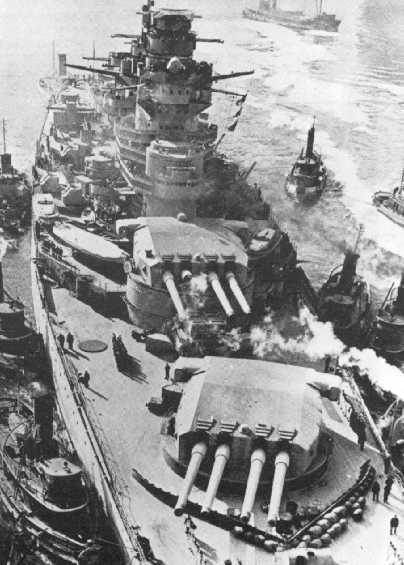
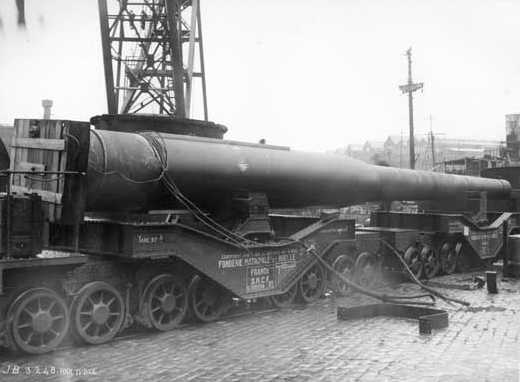

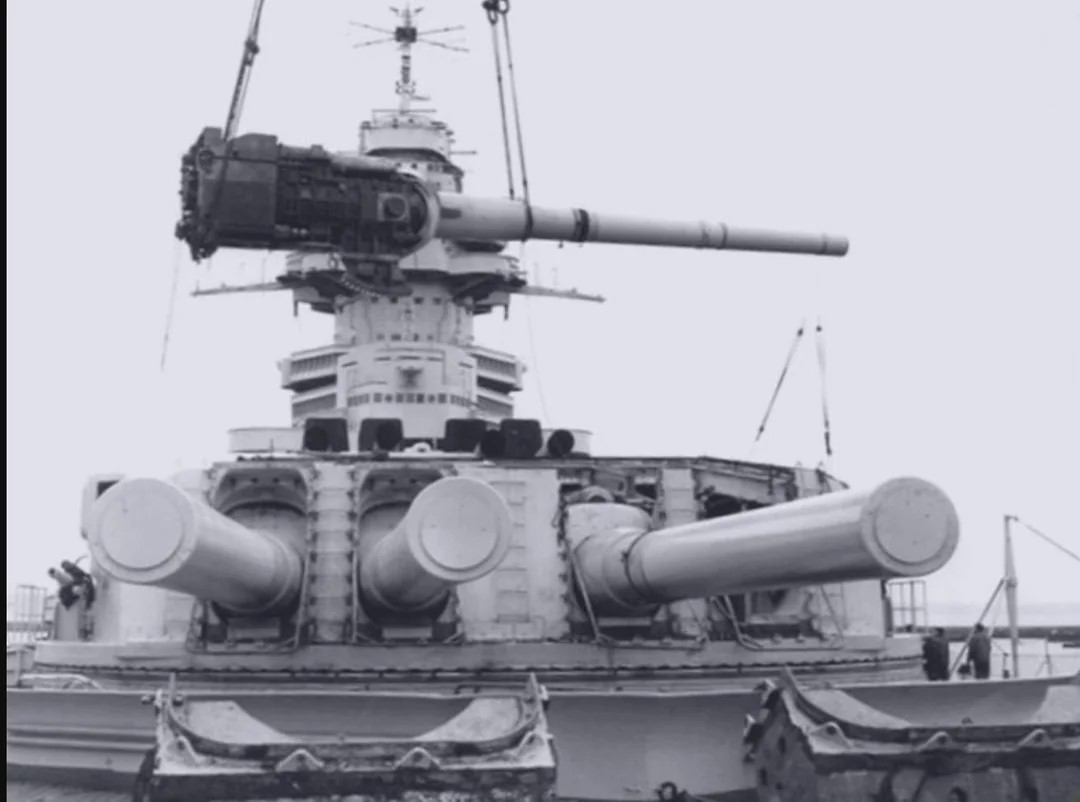
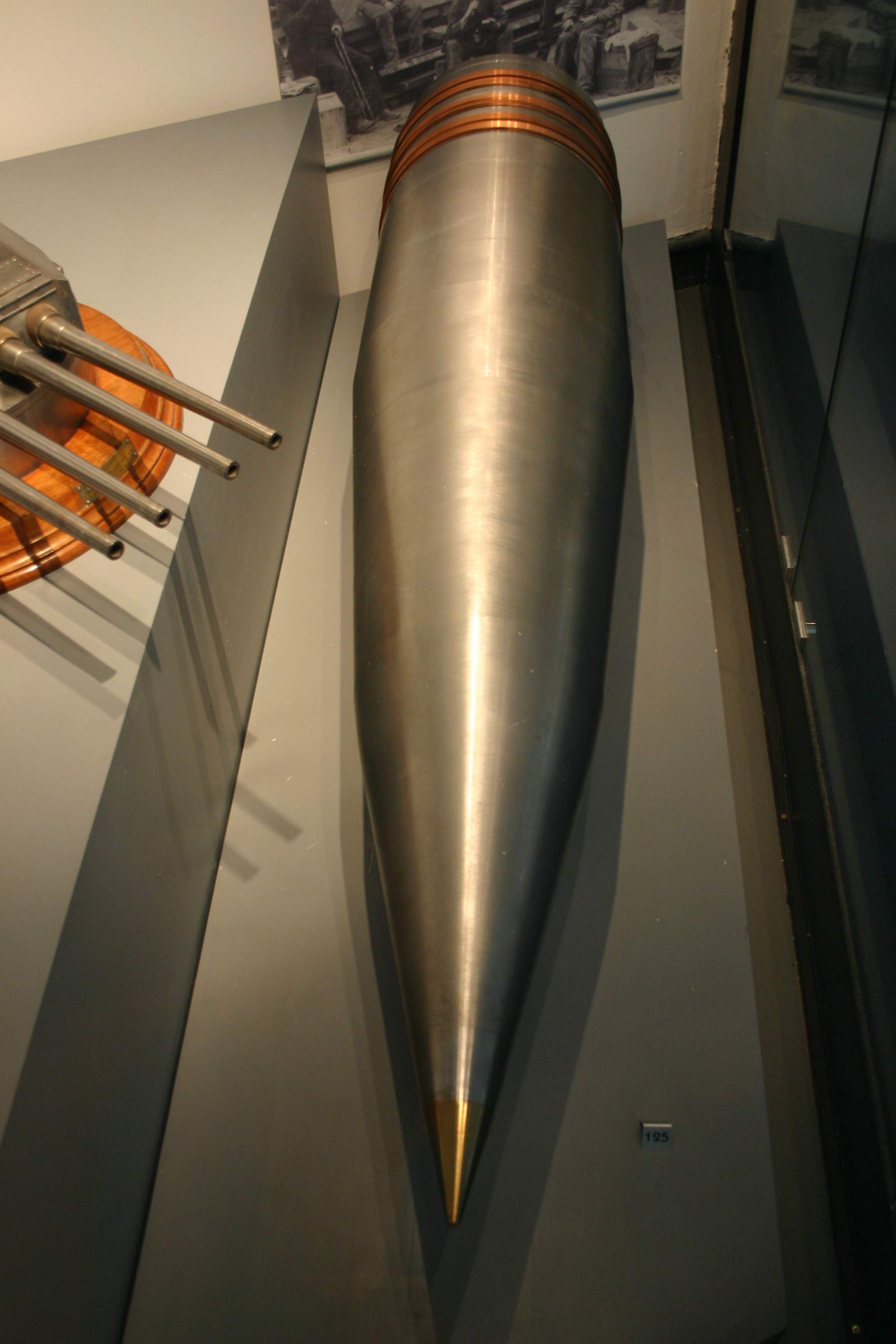
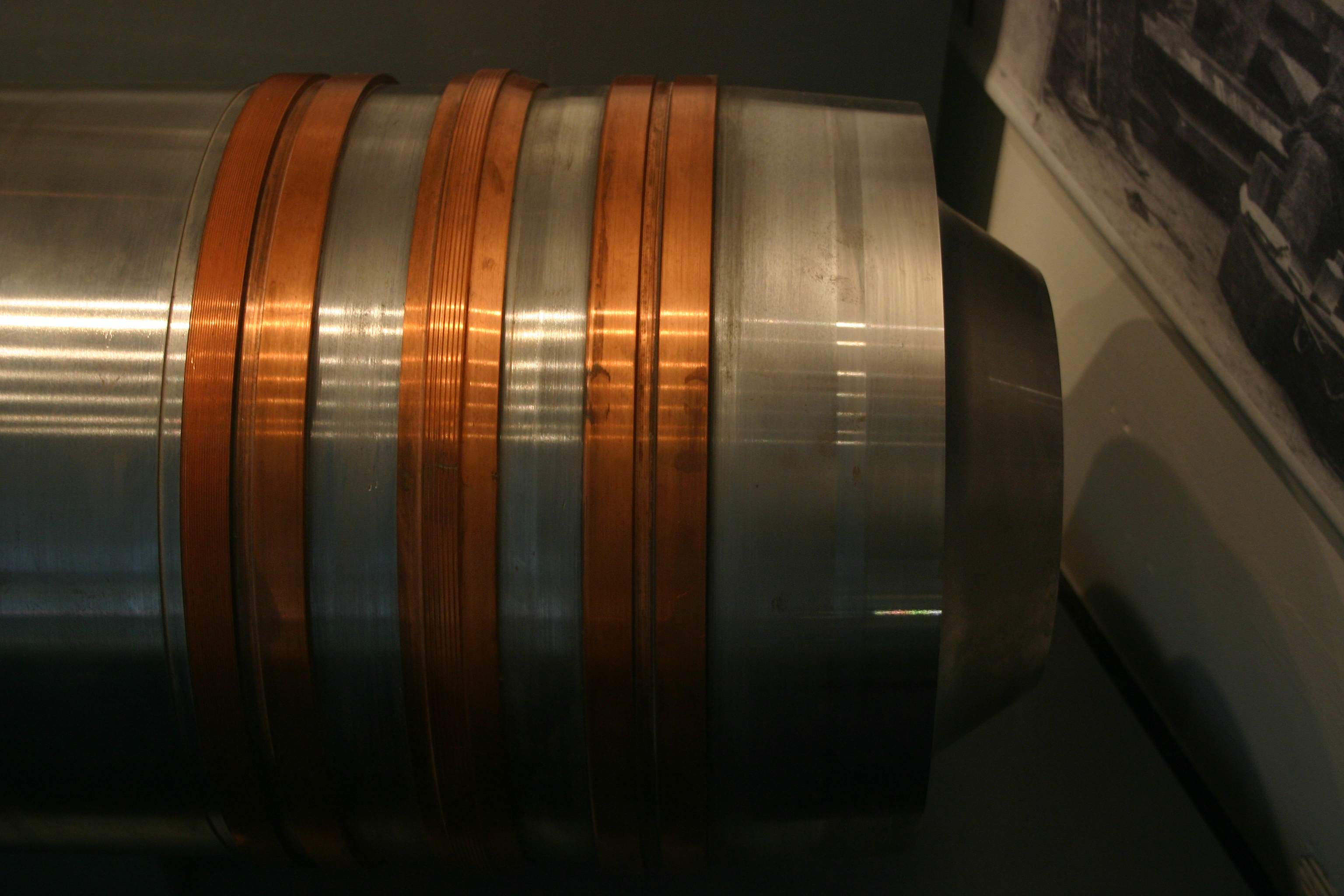
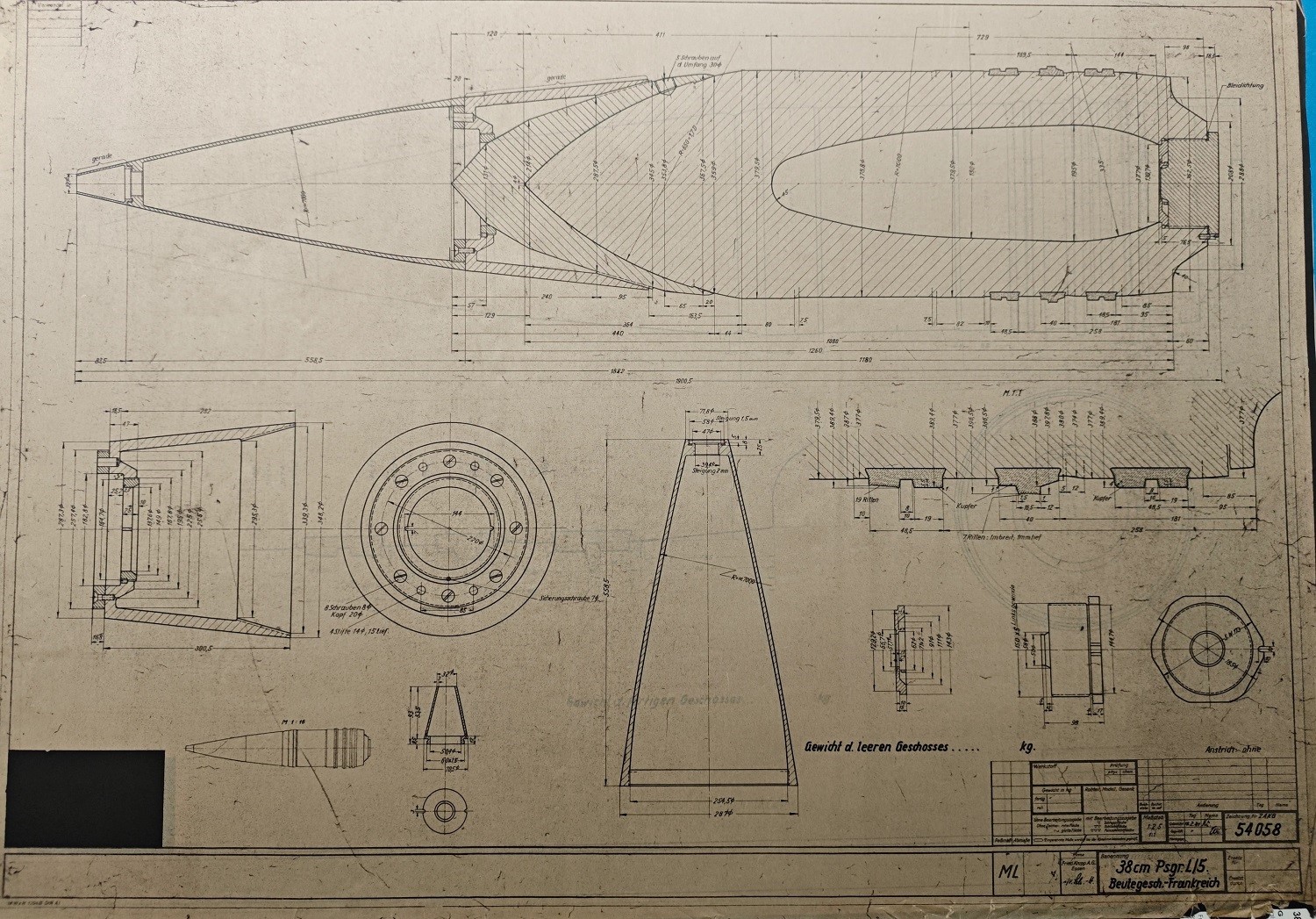
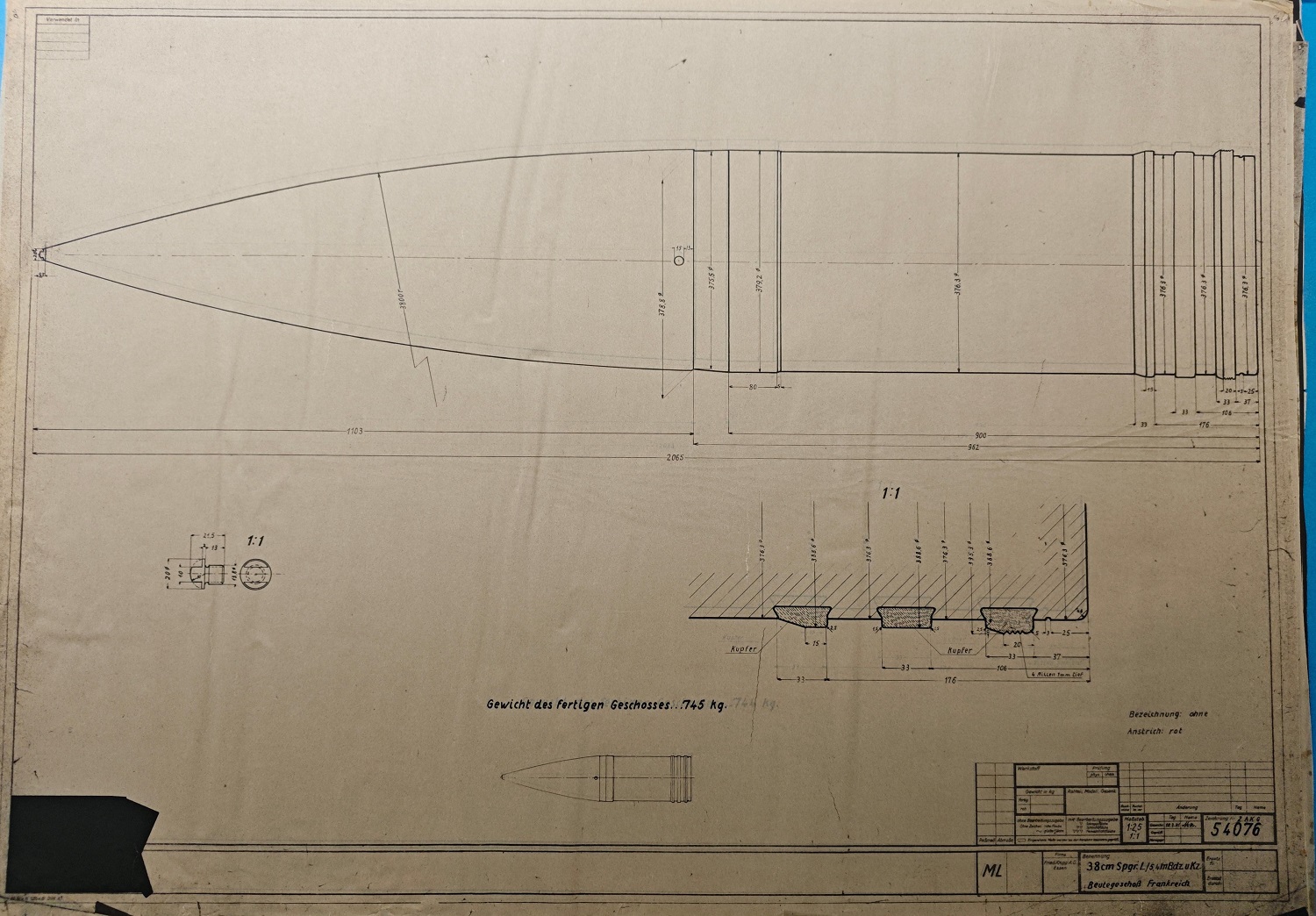
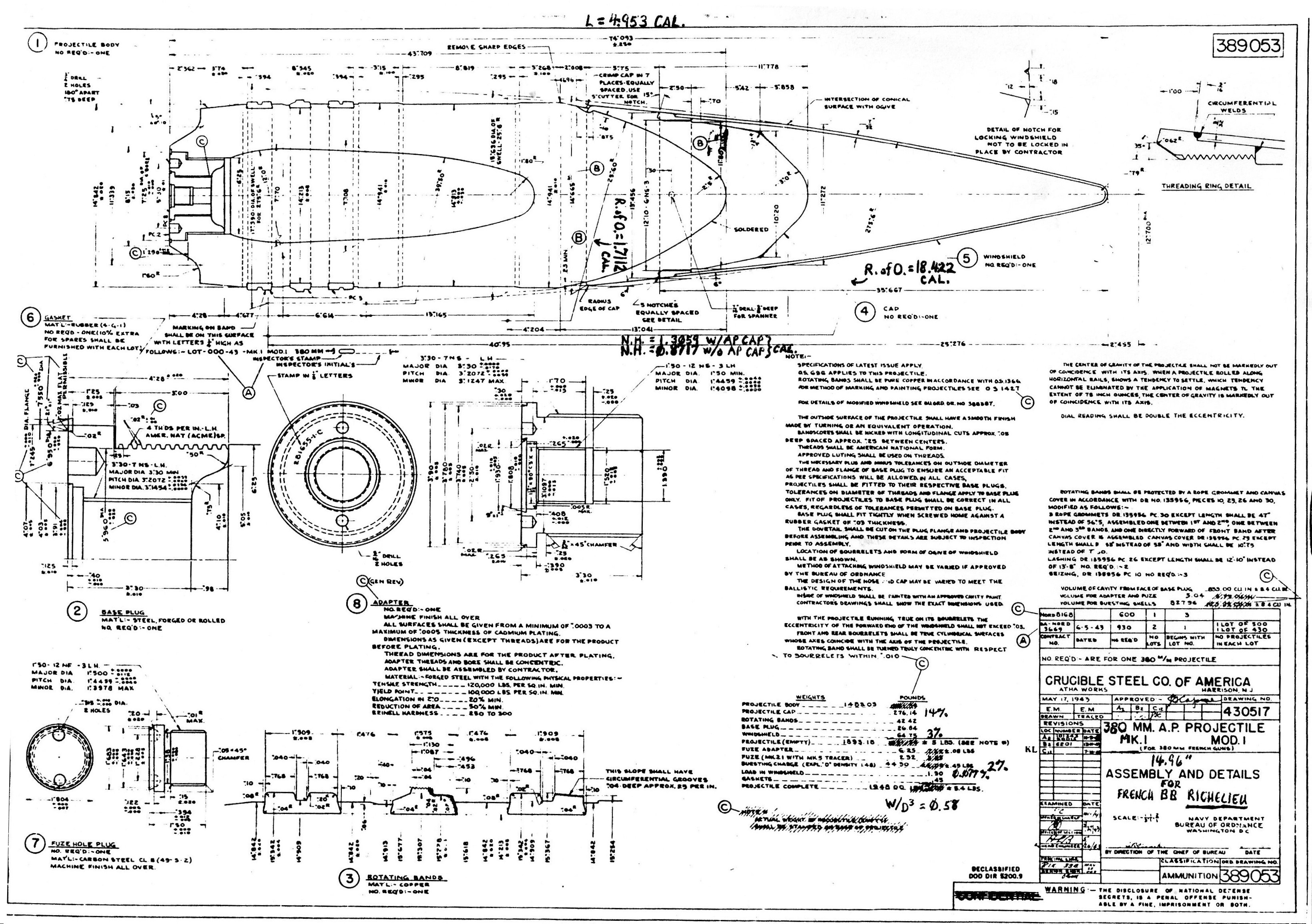
"Battleships of the World 1905-1970" by Siegfried Breyer
"Naval Weapons of World War Two" by John Campbell
"Les Cuirassés: Dunkerque, Strasbourg, Richelieu & Jean Bart" by Robert Dumas
"Battleships: Allied Battleships in World War II" by W.H. Garzke, Jr. and R.O. Dulin, Jr.
"French Battleships: 1922 - 1956" by John Jordan and Robert Dumas
"Richelieu" by René Sarnet and Eric Le Vaillant
"Battleships of World War Two" by M.J. Whitley
---
Ministère de la défense
---
"Anlage zur Übersicht über die für die Marinegeschütze und deren Abk K zu verwendende Munition und ihre Einzelteile einschließlich Salut-
und Manöverladungen.- Munition für die Geschütze des Auslandes" M.Dv. Nr. 198 by Oberkommando der Kriegsmarine
---
Special help by William Jurens, Nathan Okun, Vincent Perdrix, John Jordan and Matthew Rodchenko
13 November 2008 - Benchmark
13 January 2009 - Fixed typographical error, made minor changes to Ammunition Notes
15 April 2009 - Added reference information to picture of Richelieu entering New York Harbor
14 December 2009 - Additional information on gun history and projectiles
15 December 2012 - Added gun at La Spezia Naval Arsenal to list of surviving guns
27 June 2019 - Converted to HTML 5 format and reorganized notes
10 March 2021 - Minor formatting changes, expanded note regarding APC weights
20 June 2022 - Minor formatting changes
15 January 2023 - Corrected ROF, minor formatting changes
26 May 2023 - Corrected typographical error
21 September 2023 - Added sketch of Crucible Steel AP Mark 1 Mod 1
04 April 2024 - Added photographs of OEA shell
10 October 2024 - Added photograph of gun being removed from Richelieu
18 December 2024 - Add German sketches of 380 mm projectiles
03 January 2025 - Added note regarding the use of German 38 cm projectiles for captured guns

